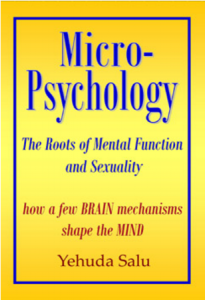PROLOG 1
SOLOMON’S BEWILDERMENT 1
BEHIND THE SCENES 3
OBSERVATIONS 7
THE STARTING POINT 7
Psychology and Micropsychology 7
Sexual attraction and arousal 8
ACTIVITY-PLANS 10
Genetic Activity-plans 10
Pheromones: Genetic arousal messengers 10
C. Elegans: A genetically hard-wired system 13
The Challenge 15
Learned activity-plans 16
Imprinting 16
Triggers of imprinting 23
Sprouting of concepts 28
States-of-mind 30
LEARNING SEXUAL AROUSAL 31
Feeling SWAP 31
Sexual SWAP and social SWAP 32
Observations in other species 34
Observations in humans 38
Off-Mainstream 38
Intimacy 42
The relation between shame, guilt and feeling SWAP 43
Fantasizing 45
SWAP and other emotions 47
SWAP and physical arousers 54
SEXUAL ORIENTATION (ATTRACTION) 57
Genes and hormones 58
Developmental disorders 58
Hormones and behavior 59
Brain morphology 61
Parenting 62
Possible genetic mechanisms 66
Token-exchange mechanisms 66
Emotion-based mechanisms 71
NEURONS AND INFORMATION REPRESENTATIONS 79
THE NEURON 79
REPRESENTATIONS 82
BRAINS AND COMPUTERS 85
LEARNING IN THE BRAIN 87
FROM NEURONS TO NODES 88
THE BASIC TYPES OF CONCEPTS AND THEIR ORGANIZATION 90
DEVELOPMENT OF INFORMATION STRUCTURES 95
From parts to items, exemplars and classes 95
Changing synaptic weights 97
Examples of sexual information structures: Ramon and Julie 100
Similarities in information structures of sexual behaviors 111
REVERSIBLE AND IRREVERSIBLE BEHAVIORS 114
The role of excitation and inhibitory synapses 114
Plasticity 116
Feelings and actions 118
Summary 119
HIGHER MENTAL FUNCTIONS 122
REFLEXES AND THINKING 122
Information retrieval 123
Modulation in data retrieval 124
Combination of basic retrievals 124
Recruitment of new nodes 125
RETRIEVAL REQUESTS 126
Basic retrieval requests 126
Appraisal of retrieved information 127
Logical combination of retrieval requests 127
Nested retrieval requests 128
Example 129
INFORMATION AND ACTIVITY-PLANS 134
MENTAL SIMULATIONS 137
Verbal thinking 138
Non-verbal thinking 140
DYNAMIC RETRIEVAL MODIFICATIONS 143
PERCEPTION 144
Detectors and activators 144
Sameness detectors 149
Opposites 150
Conflict detectors 151
Data processing detectors 156
Temporal detectors 156
Order detectors and mathematics 157
Status detectors 158
Other detectors 160
The limits of human perception 160
UNDERSTANDING 164
Bloom’s Taxonomy 164
Example 165
Basic nodal processes and the Taxonomy 171
Itemization and classification 171
Detectors in the Taxonomy 172
Retrieval in the Taxonomy 173
Intelligence 176
Information halo 178
The role of itemization and classification detectors 180
The thinking apparatus 181
The Savant Syndrome 184
Math wizards, history buffs, and sports mavens 185
In a Nutshell 189
DRIVES 190
Drives and activity-plans 190
Homeostasis 192
Expanded drives 195
Operant conditioning 196
ORGANIZATION OF BEHAVIOR 198
Activities-coordinator 198
Example 200
Acquired drives and addiction 201
CONCLUDING REMARKS 203
The principles 203
Some implications and applications 206
Teaching 206
Advertising and public relations 210
Sexuality 212
Free will 217
INDEX 221
